With some prognosticators saying 2012 will be the end of the world, do you want to chance spending the last year of your life unable to really crank up your stereo? Musical Fidelity is known for making “super integrated” amplifiers; its the new M6 500i represents another benchmark in this field.
The British company’s M6 500i is tough to resist. Especially when I don a Darth Vader mask and convince you the force is strong in this dark, monolithic machine. Can you feel it? You’ve had the urge to upgrade your current little integrated. Now focus. Forget about those telling you power isn’t important. It is, and the M6 500i delivers 500 glorious, window-rattling, tweeter-melting watts per channel that will take you from the back of the arena to the front row. Sense your desire for more power getting stronger? Let anger consume you as you contemplate ditching your current amplifier. Good.
With the M6 5001, listeners equipped with inefficient speakers will no longer be doomed to experience Metallica or Shostakovich at inferior volume levels. Remember, lifelike dynamic swings are just as important to musical accuracy as tonal accuracy. Even Shania Twain sounds better with oodles of power behind her. And the M6 500i’s tremendous bass control keeps speaker woofers pulsating.
The M6 500i features four RCA line-level inputs (one of which is switchable between AUX or HT pass-through) and one balanced XLR input. Compatibility with most systems should be simple. I’d love to see another balanced input, but for $6,995, you can’t have everything. The M6 500i also includes tape out jacks and a variable level (RCA jack) output for those who might want to add a powered subwoofer or two.
This unit isn’t merely a high-powered brute. You won’t mistake it for that of a Burmester, but the metalwork is top-shelf. Finish quality is highly uniform, the front panel convincingly massive, and the volume control substantial. Buttons are tastefully small, and a nice remote is included. Fonts are stylish and understated. No giant logos, either—another mark that bridges the gap between a top-line component and a budget sibling.
Repeat after me: Exceptional Value Award. The M6 500i comes in silver, too, but as the late-night spy Archer would say, “Why would you?” Black suits its powerful nature just right.
Forewarning
Once you drive a Dodge Challenger with a Hemi under the hood, the wimpy six-cylinder model at the National rental counter always sucks—no matter how much Patrick Stewart tries to convince you otherwise. And so it goes with a well-designed, high-power amplifier. Adding the 3,000-watt JL Audio Gotham subwoofer to the system and spinning Iggy and the Stooges’ Raw Power Live: In The Hands Of The Fans, the M6 500i becomes both Death Star and time machine. Giving the volume control a forceful spin and closing my eyes puts me right back at that legendary September 2010 show, where editor Bob Gendron and I saw Pop passed right through the crowd. That’s realism.
But remember, power corrupts. If you aren’t careful, you might damage your hearing—or speakers—with the M6 500i. Case in point: A few bottles of Maudite placed TONEAudio contributor Jerold O’Brien and I in full-on Beavis and Butthead mode as we proceeded to liquefy a pair of AR3a speakers just like we did when we were younger. And while a small amplifier driven to clipping handily destroys a tweeter, a big amplifier driven to clipping scorches woofers, and usually involves minor pyrotechnics. That’s exactly what happened.
Feeling like the wise old owl in the Tootsie Pop commercial, we wanted to see how many minutes of Sepultura it would take to completely destroy the AR3as. The answer? Two minutes and fifteen seconds of “Stronger Than Hate” from Beneath the Remains, and the speakers were lifeless carcasses. We ended the festivities, as the M6 500i ‘s force kept growing stronger. We momentarily considered vaporizing O’Brien’s Vandersteen 1Cs.
The next morning, as we headed out to Denny’s for a Grand Slam breakfast (don’t let friends drive home drunk, especially when they are hopped up with the thrill of destruction), we pondered if it was all just a dream. Nope. The smell of burned electric components still filled the listening room. Heavenly.
Mixing synergies with the Verity Audio Amadis, Magnepan 1.7s, Peak Consult Kepheus, and a handful of other speakers proves highly enjoyable, regardless of program material. The M6 500i makes for a great system anchor as it opens the door to whatever speakers you have or might want in the future. Even the Magnepans, which need power in the manner a neurotic girlfriend needs attention, lit up with the M6 500i.
Lest you think we are all headbanging maniacs at TONEAudio, rest assured the M6 500i features a high level of refinement and tonal finesse that suits all types of music. While this high-powered solid-state amplifier won’t fool you into thinking you are listening to a pair of tubed monoblocks, it is never harsh or strident.
Evaluating current Audio Wave XRCDs illustrates such traits. Walter Bishop’s piano on Jackie McLean’s Swing, Swang, Swingin’ just glides through the background of the tune, never dropping off the beat. Cymbals are crisp, awash with lingering decay. When McLean enters, his sax is chock full of texture, bouncing from simmer to boil, and then overflows outside the speaker boundaries as the tempo increases.
Is there anything the M6 5001 cannot do? Not really. Sure, a couple of the higher-priced integrateds possess more midrange sweetness, and more resolution, but they cost two-to-four times as much. You get what you pay for with the megabuck amps, yet you get tremendous performance and value with the M6 500i. Separates aren’t the answer, either. You’ll be hard pressed to find a 500-watt-per-channel power amplifier that delivers the goods for $7k—and you’ll still need a preamp and pair of interconnects. And Darth Vader’s got no use for such extra troubles when galaxy-conquering power can be had from one box.
Musical Fidelity M6 500i Integrated Amplifier
MSRP: $6,995
www.musicalfidelity.com (Factory – UK)
www.temposales.com US Distributor
Peripherals
| Analog Source | AVID Volvere SP Funk Firm FX•R Denon DL 103R |
| Digital Source | dCS Debussy Sooloos Control 15 Mac Mini |
| Speakers | AR3a (deceased) Vandersteen 2Ce Signature Magnepan 1.7 Verity Audio Rienzi B&W 802 Diamond MartinLogan Montis |
| Cable | Cardas Clear Light |
| Power | PS Audio P10 |



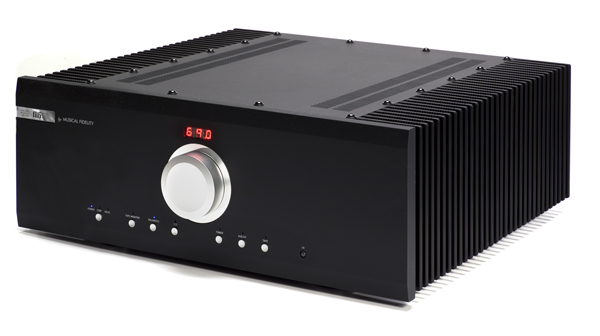
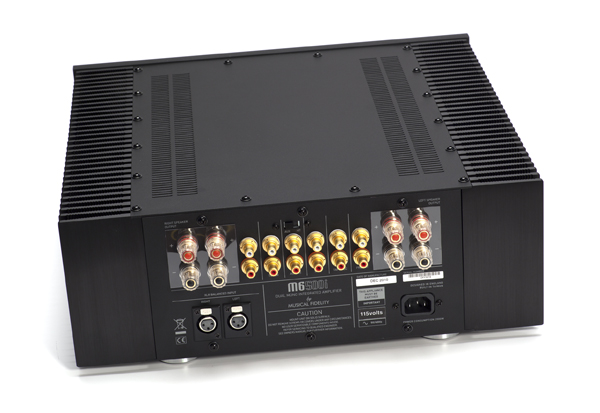
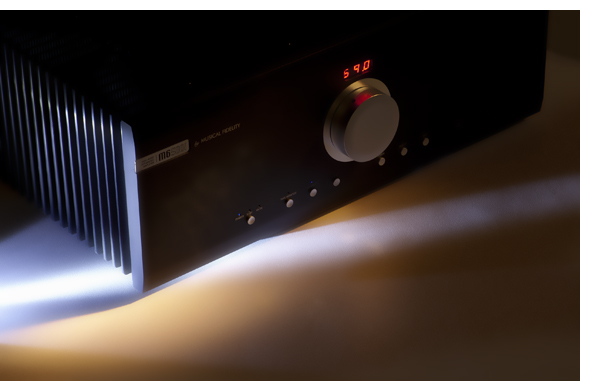
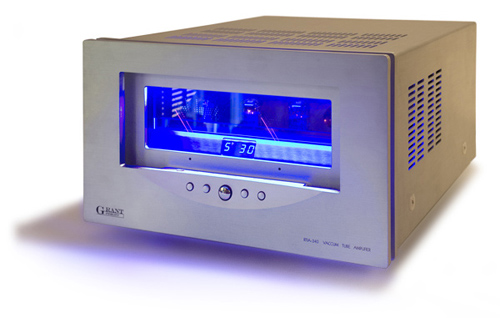 If you like tube amplifiers that hanker back to the glory days of audio with a big, beefy chassis and huge output transformers, the Grant Fidelity Rita-340 is for you. It’s so robustly built that even the careless handling of the UPS guys couldn’t stop it! The substantial crate arrived, looking like it had been dropped off the top of my garage roof, but after I dusted off the Rita and fired it up it worked perfectly and it has worked flawlessly for the past six months. I think this should settle any build questions you might have about this amplifier; anything that can survive that kind of abuse should be fine in everyday use.
If you like tube amplifiers that hanker back to the glory days of audio with a big, beefy chassis and huge output transformers, the Grant Fidelity Rita-340 is for you. It’s so robustly built that even the careless handling of the UPS guys couldn’t stop it! The substantial crate arrived, looking like it had been dropped off the top of my garage roof, but after I dusted off the Rita and fired it up it worked perfectly and it has worked flawlessly for the past six months. I think this should settle any build questions you might have about this amplifier; anything that can survive that kind of abuse should be fine in everyday use.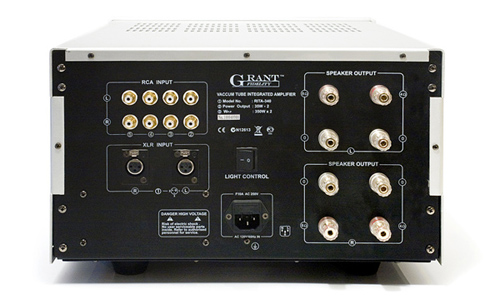 There are two sets of speaker outputs on the rear panel, and while the amplifier is rated to drive speakers from 4-8 ohms, with a tap for 4 and 8 ohms and a common ground. The speakers I tried had varying impedance and I did not notice any issues driving anything.
There are two sets of speaker outputs on the rear panel, and while the amplifier is rated to drive speakers from 4-8 ohms, with a tap for 4 and 8 ohms and a common ground. The speakers I tried had varying impedance and I did not notice any issues driving anything.










